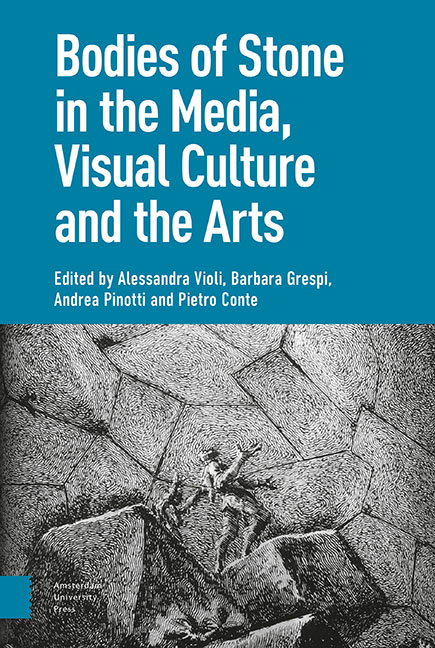Book contents
- Frontmatter
- Contents
- Introduction: Learning from Stone
- I Statue: The Imaginary of Uncertain Petrification
- 1 Theatre and Memory: The Body-as-Statue in Early Modern Culture
- 2 Translated Bodies: A ‘Cartographic’ Approach
- 3 Pantomime in Stone: Performance of the Pose and Animal Camouflage
- 4 Animated Statues and Petrified Bodies: A Journey Inside Fantasy Cinema
- 5 The Ephemeral Cathedral: Bodies of Stone and Configurations of Film
- II Matter: Size, Hardness, Duration
- 1 Bodies That Matter: Miniaturisation and the Origin(s) of ‘Art’
- 2 Brancusi’s ‘Sculpture for the Blind’
- 3 Cinema, Phenomenology and Hyperrealism
- 4 Ephemeral Bodies: The ‘Candles’ of Urs Fischer
- 5 The Celluloid and the Death Mask: Bazin’s and Eisenstein’s Image Anthropology
- III Corpse: Fossils, Auto-Icons, Revenants
- 1 Funeral Eulogy: Post-Mortem Figures and Redeemed Bodies, in Images
- 2 On Jack Torrance As a Fossil Form
- 3 Technical Images and the Transformation of Matter in Eighteenth-Century Tuscany
- 4 Glass, Mixed Media, Stone: The Bodily Stuffs of Suspended Animation
- 5 Bodies’ Strange Stories: Les Revenants and The Leftovers
- IV Monument: Embodying and Grafting
- 1 The Impassibly Fleshly, the Statue of the Impossible
- 2 Frozen into Allegory: Cleopatra’s Cultural Survival
- 3 The Orphan Image
- 4 The Well-Tempered Memorial: Abstraction, Anthropomorphism, Embodiment
- 5 Monuments of the Heart: Living Tombs and Organic Memories in Contemporary Culture
- Index
4 - The Well-Tempered Memorial: Abstraction, Anthropomorphism, Embodiment
Published online by Cambridge University Press: 20 November 2020
- Frontmatter
- Contents
- Introduction: Learning from Stone
- I Statue: The Imaginary of Uncertain Petrification
- 1 Theatre and Memory: The Body-as-Statue in Early Modern Culture
- 2 Translated Bodies: A ‘Cartographic’ Approach
- 3 Pantomime in Stone: Performance of the Pose and Animal Camouflage
- 4 Animated Statues and Petrified Bodies: A Journey Inside Fantasy Cinema
- 5 The Ephemeral Cathedral: Bodies of Stone and Configurations of Film
- II Matter: Size, Hardness, Duration
- 1 Bodies That Matter: Miniaturisation and the Origin(s) of ‘Art’
- 2 Brancusi’s ‘Sculpture for the Blind’
- 3 Cinema, Phenomenology and Hyperrealism
- 4 Ephemeral Bodies: The ‘Candles’ of Urs Fischer
- 5 The Celluloid and the Death Mask: Bazin’s and Eisenstein’s Image Anthropology
- III Corpse: Fossils, Auto-Icons, Revenants
- 1 Funeral Eulogy: Post-Mortem Figures and Redeemed Bodies, in Images
- 2 On Jack Torrance As a Fossil Form
- 3 Technical Images and the Transformation of Matter in Eighteenth-Century Tuscany
- 4 Glass, Mixed Media, Stone: The Bodily Stuffs of Suspended Animation
- 5 Bodies’ Strange Stories: Les Revenants and The Leftovers
- IV Monument: Embodying and Grafting
- 1 The Impassibly Fleshly, the Statue of the Impossible
- 2 Frozen into Allegory: Cleopatra’s Cultural Survival
- 3 The Orphan Image
- 4 The Well-Tempered Memorial: Abstraction, Anthropomorphism, Embodiment
- 5 Monuments of the Heart: Living Tombs and Organic Memories in Contemporary Culture
- Index
Summary
Abstract
This paper addresses some crucial categories in contemporary practices of memorialisation and public sculpture, including the polarities of “abstraction / figuration” and “transitivity / intransitivity” and the questions of anthropomorphism and embodiment. Referring to paradigmatic cases belonging to different media—sculpture, architecture, video installations—and comparing different memorialistic subjects (the Holocaust memorials, the Italian fascist sacraria, the monuments dedicated to the Vietnam war), the chapter investigates the dialectics of presence and absence in the relationship between the present material body of the monument and the absent bodies evoked by the process of memorialisation.
Keywords: Abstraction; anthropomorphism; embodiment; memorialisation; monumentality
Abstraction
In the complex landscape of contemporary monumental practices and strategies of memorialisation, the class of memorials specifically devoted to the Shoah offers an incomparable richness of cases that articulate in apparently inexhaustible ways the relationship between image and memory.
At first sight, a major difference splits this class into two principal subclasses: figurative and abstract. However, such a distinction is highly problematic from the point of view of the aesthetics of visual arts: although the first so-called abstract watercolour by Kandinsky was realised more than one hundred years ago, a unanimously agreed definition of ‘abstraction’ is still a desideratum, and the very term ‘abstract’ has been frequently disputed and challenged by cognate denominations such as ‘non-figurative’, ‘non-objective’, ‘non-representational’ (in the German-speaking literature, the term is often dismissed in favour of the adjective gegenstandslos, literally ‘with no object’). In an essay published in 1938, Kandinsky himself took up the formulation ‘concrete art’, coined eight years earlier by Theo van Doesburg to characterise precisely what in ordinary discourse is usually designated as ‘abstract’ art.
A series of controversial issues related to the core of visual representation affects this discussion of visual representation performed both by bi-dimensional and by three-dimensional images: resemblance, likeness, recognition and reference. These issues have engaged various disciplinary approaches: from formalism to semiotics, from phenomenology to analytic theories of depiction. I am well aware of the open and unsolved status of this scenario.
- Type
- Chapter
- Information
- Bodies of Stone in the Media, Visual Culture and the Arts , pp. 325 - 342Publisher: Amsterdam University PressPrint publication year: 2020

